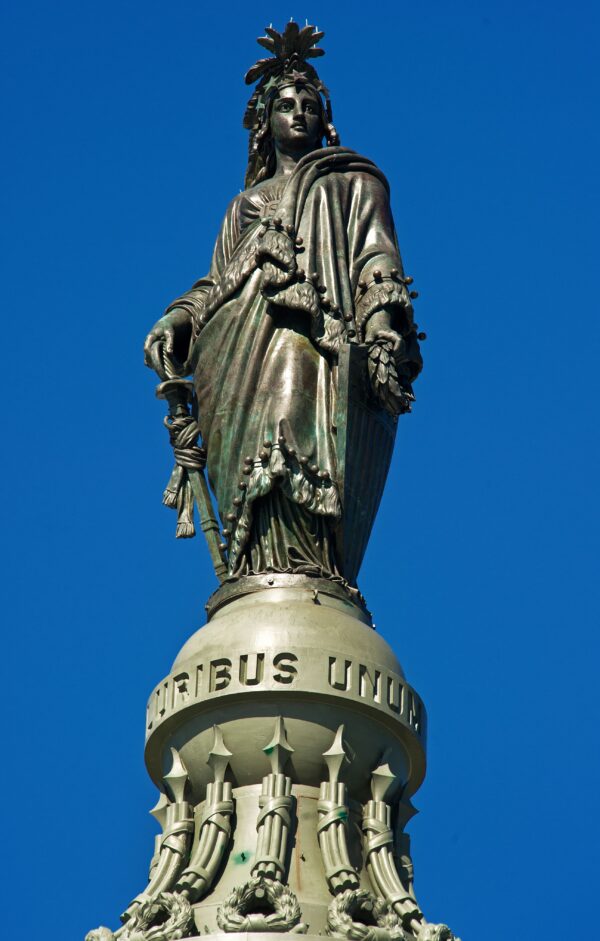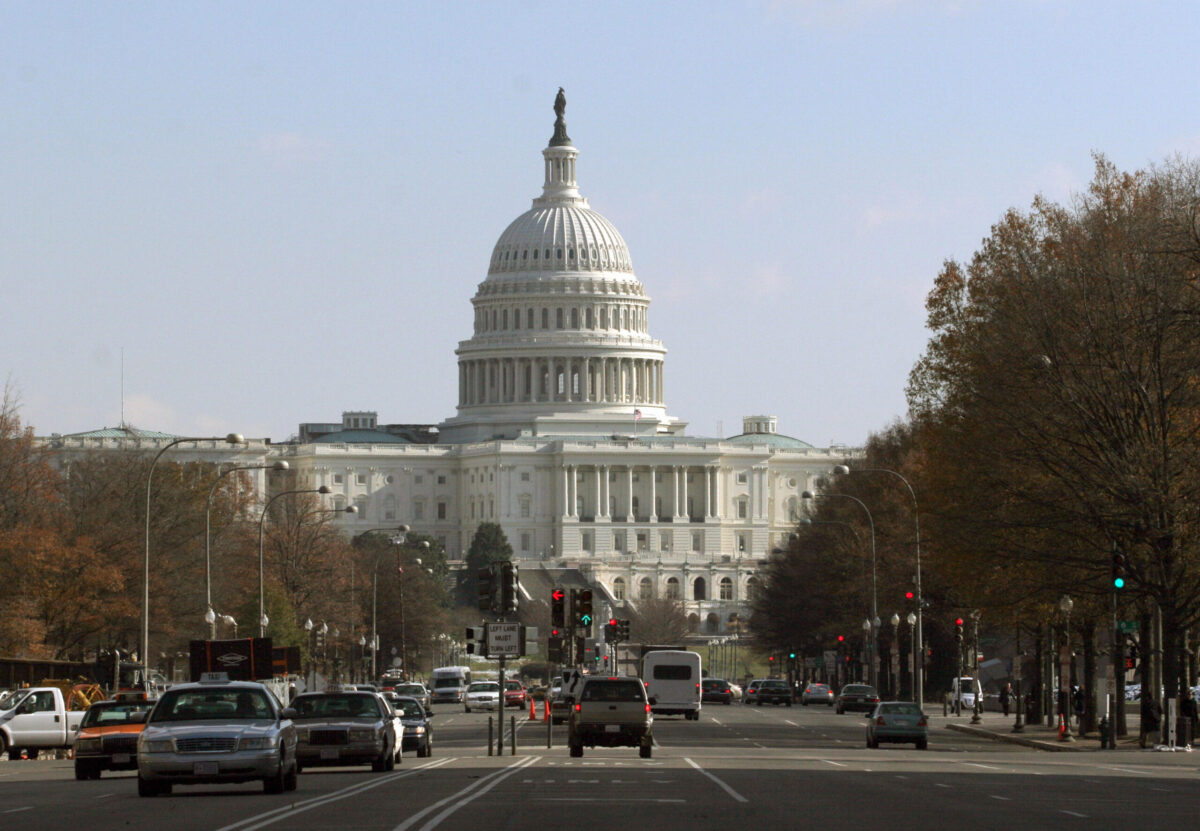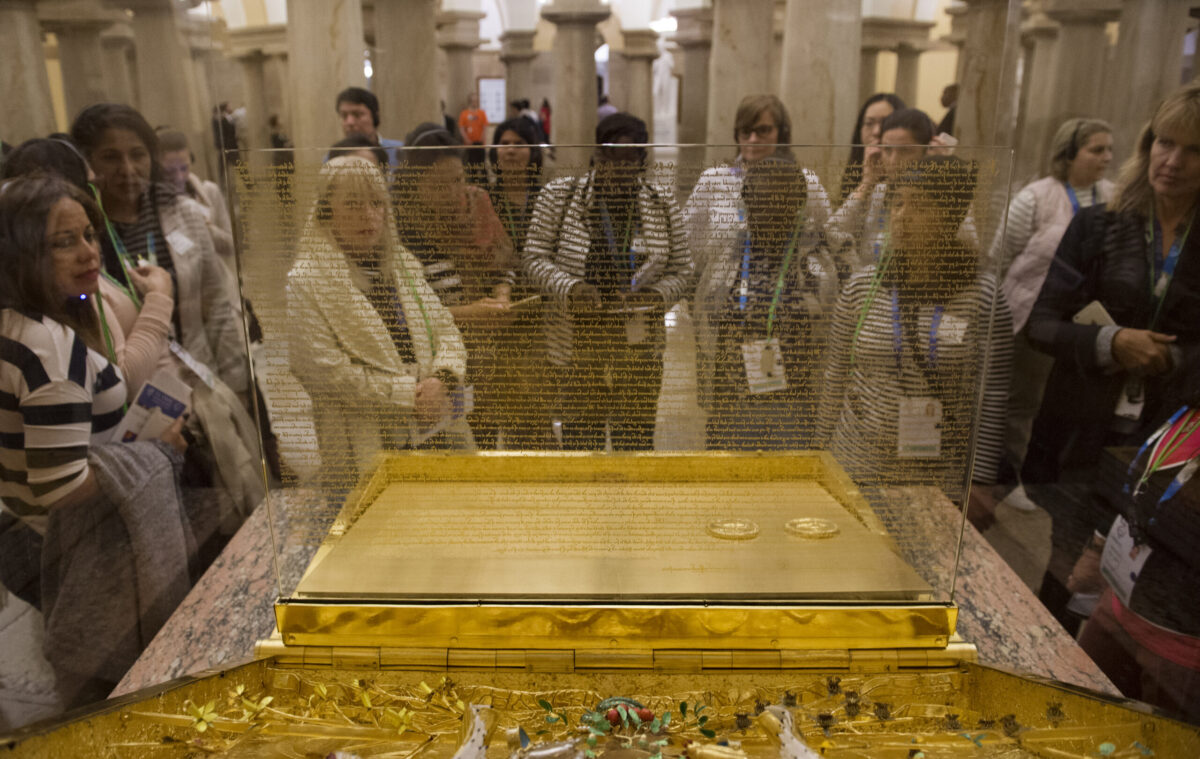As I step outside the House chamber on the second floor of the Capitol, I guide my visitors halfway down the stairs outside, offering them a sweeping view of the Supreme Court building and the Library of Congress. That’s when I call their attention to something else altogether—the crowning achievement, literally, of the Capitol: the Statue of Freedom, perched atop the dome, solitary, magisterial.
It is perhaps the most recognizable feature of the Capitol, an iconic world image of liberty and government by the people. Peering into the distance nearly 300 feet above the East Front Plaza, the bronze statue is of epic dimensions, soaring almost 20 feet high and weighing about 15,000 pounds. Freedom is decked out in an elaborate headdress topped by an eagle head and feathers. Her flowing dress is cinched with a large brooch emblazoned with two letters: U.S. In her right hand, she clasps a sheathed sword, while the other clutches a laurel wreath of victory and a shield.
The Statue of Freedom perched atop the Capitol is something to behold and serves as a symbol of my stewardship as a member of Congress, which is why I selected that image of the Capitol dome to adorn my letterhead. This is what I want my constituents to see, to be reminded of, when I write to them.
The Statue of Freedom also symbolizes the personal quest for freedom of one man, Philip Reid, born into slavery in Charleston, South Carolina, in 1820. In one of the great ironies of American history, Reid, as a slave, was assigned the complex project of creating and placing one of the world’s most powerful symbols of freedom on the most visible building in our nation.

I’ll admit, I didn’t know the story of Reid until after I became a member of Congress and got the lowdown on the history of the Capitol from those in the know. But once I heard about Reid’s remarkable story, I delved deeper, reading more about it online. I mention all this about Reid during my tours, and though not one of my visitors has ever known the story beforehand, they are surely glad to hear it. Slavery is a terrible stain on our history, but my guests are palpably proud of how far America has come since then.
The statue was commissioned in 1855. Thomas Crawford, an American sculptor, created the plaster model of the statue in Rome, Italy. After his death in 1857, his widow shipped the statue in six crates, and the model was assembled and placed in what is now Statuary Hall. The following year, Clark Mills, a self-taught sculptor, was given the task of casting Freedom. Mills started his business in South Carolina, where he purchased Reid for $1,200. Reid dismantled the model in the Capitol, cast the individual sections, and finally assembled and mounted the bronze sections atop the dome.
On April 16, 1862, as Reid supervised the creation of the statute’s massive bronze sections, Congress passed the District of Columbia Emancipation Act, freeing thousands of slaves living within the district. That included Reid. As a free man, he kept working for Clark Mills. At noon, on December 2, 1863, under Reid’s supervision, the top section of the Statue of Freedom was raised and bolted on top of the Capitol dome.
Many of the experts with whom I have toured the Capitol offered various explanations for the direction the Statue of Freedom faces. Some say Freedom faces east because every morning she watches the sun rise on America with a new day of liberty for all. Others say she faces east because the primary entrance to the Capitol is on the east side, or because most residents of Washington, D.C., at the time lived on the east side. Yet others suggest she faces east because European settlers came from that direction.

As the foreman in the casting of the Statue of Freedom, Philip Reid stepped in when an Italian sculptor hired to assemble the five sections refused unless granted a pay raise. It was Reid who figured out how the pieces were separated and put together. He was paid $1.25 a day, though his owner received those payments, except on Sundays, when it was his own. Mills, the man who bought Reid, described him as “short in stature, in good health, not prepossessing in appearance, but smart in mind.”
Reid was a freed man by the time the last piece of the Statue of Freedom was assembled in December 1863. He went on to become a respected businessman, identified in census records as a “plasterer.” While a plaque to Reid resides not at the Capitol, but where his remains lie at the National Harmony Memorial Park in Landover, Maryland, his place in history—and on my tour—remains resolute.
Excerpted from the 2020 book, “Capitol of Freedom: Restoring American Greatness,” by Colorado Rep. Ken Buck.





